A Three-Part Series of Articles
In Part 1 of this 3-part article, we defined forgiveness as the intentional process by which someone who’s been hurt undergoes a change in feelings and attitude regarding an offense, lets go of a need for revenge, and feels some empathy toward the offender.
In Part 2 of this series, we looked at common beliefs and misconceptions that we have about forgiveness.
Now let’s consider the actual steps to forgiveness. How do we forgive someone who has wronged us?
Grief and forgiveness are two sides of the same coin. They are processes that help us heal our hurts and unresolved feelings. Authors have described many different “models” of forgiveness, but almost all of them start with the same step:
(1) Name the hurt! We can’t forgive something that did not occur. We have to name the person who hurt us, name the words or action that hurt us, and give voice to the emotions that we felt as a result of the hurt. Maybe we felt helpless, humiliated, shamed, stepped on, belittled, pushed aside, victimized, devastated, or any combination of these emotions.
Several forgiveness models emphasize understanding, empathy and compassion for the wrongdoer and letting go the need to retaliate. However, this can short-circuit the forgiveness process and we can forgive too soon. There is a lot to be processed between the offense and the forgiveness. This brings us to step 2:
(2) Process your feelings. Validate that the hurtful event really happened and that it truly affected you. Once the emotions have been named, they can be processed in various ways: Express those feelings in a letter that you may not send. Share them with someone in your support group. Express them in a journal, to a trusted friend, or even to the wrongdoer if that person is open to hearing your feelings. Anger and hurt have a lot of energy and need somewhere to go.
(3) Understanding. Most forgiveness models urge the victim to understand the offender’s point of view. This is indeed an important step, but I think that it is important first to understand the forgiver’s point of view. Once I understand my own point of view, how I was offended, and named and processed the feelings, then I can begin to understand and empathize with the offender. Self-understanding leads to understanding the other. Again, that understanding can come by journaling, talking to a trusted friend, or listening to someone in a support group and finding that I am not the only one who thinks this way.
Once I am ready, I can begin to think about the other’s point of view, what might be going on in their life to make them act that way. I can come to some understanding about where they are coming from. I may even discover that the offense was unintended. I may discover their intentions were good, but the action was misguided. Even if someone is intentionally hurtful, I can empathize with their life situation or motivation. Perhaps they had been hurt themselves, and rather than deal with their pain, they tried to pass their hurt along to someone else.
(4) Compassion. As in step 3, I think it is important to look at compassion from both points of view. This means having compassion for myself and then, feeling compassion for the offender. But we start with self-compassion. We are kind to ourselves. If we do not feel like forgiving just yet, we may need to go slowly and allow ourselves the full expression of our feelings in step 2. Once we allow ourselves to go slow, we may be able to develop compassion for the other. Note that compassion does not mean befriending or reconciling with the offender. You do not have to reconcile with someone who treated you badly.
(5) Proceed at your own pace. Forgiveness is not a smooth, straight-line journey. It has zigzags, loops, and byways. It is a choice. You may need to move back and forth between the steps. For example, if it is too soon to feel compassion for the offender, maybe you need to revisit the hurtful act and your emotional response more thoroughly, checking for hurts that are still buried and not fully realized. Or maybe you need to work harder at understanding the offender’s point of view, past hurts, or possible motivations in order to let go of a need to retaliate.
(6) Finally: How do you know that you have forgiven someone? Consider these questions:
Have I given up fantasies of revenge?
Is my first thought of them positive?
Would I help them if they were in trouble?
Do I wish them well?
If you can answer “yes” to these questions, you have come a long way in your forgiveness journey. If not, you may have some more work to do.
Grief and forgiveness are two sides of the same coin. They are processes that are worth the effort. Working through forgiveness and letting go of the hurt frees us from the chronic, smoldering anger of resentment, eases our hurts, improves our health, and frees us to devote more energy to the relationships in our lives that matter the most.
THE END
-Kathy Telger M.Ed., LPC-S


